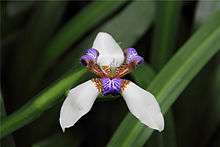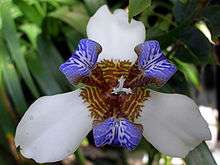Neomarica
| Neomarica | |
|---|---|
 | |
| Neomarica caerulea | |
| Scientific classification | |
| Kingdom: | Plantae |
| Clade: | Angiosperms |
| Clade: | Monocots |
| Order: | Asparagales |
| Family: | Iridaceae |
| Subfamily: | Iridoideae |
| Genus: | Neomarica Sprague |
| Type species | |
| Neomarica northiana (Schneevogt) Sprague | |
Neomarica (walking iris, apostle's iris or apostle plant – names also used for the related genus Trimezia) is a genus of plants in family Iridaceae, first described in 1928. It is native to Mexico, Central and South America, and Trinidad & Tobago.[1][2][3][4]
The genus name is derived from the Greek words neo, meaning "new", and Marica, the Roman nymph.[5]
Description
They are herbaceous perennial plants that propagate by way of a thick rhizome and new plantlets that develop from the stem where flowers once emerged. The plants grow erect, and have long slender lanceolate leaves from 30–160 cm long and 1–4 cm broad, depending on the species. They produce very fragrant flowers that last for a short period of time, often only 18 hours.
The flowers emerge from what appears to be just another leaf, but is really a flower stalk structured to look like the other leaves; they are 5–10 cm diameter, and somewhat resemble Iris flowers. After pollination, the new plantlet appears where the flower emerged and the stalk continues to grow longer. The weight of the growing plantlet causes the stalk to bend toward the ground, allowing the new plantlet to root away from its parent. This is how it obtained the common name of "Walking Iris". The other common name "Apostle Plant" comes from the belief that the plant will not flower until the individual has at least 12 leaves, the number of apostles of Jesus.
Taxonomy
Neomarica is placed in the tribe Trimezieae, along with the genera Trimezia, Pseudotrimezia and Pseudiris.[6] Neomarica is similar to the genus Trimezia; the same common names are used for both genera. Morphological characters that have been used to distinguish the two include the flower stalk (scape): in Neomarica it is flattened and leaf-like whereas in Trimezia it is circular in cross-section.[7] (See Trimezia: Distinction from Neomarica.) However, molecular phylogenetic studies have not upheld any of the genera within the tribe Trimezieae; three of the four main clades found combine species from more than one genus.[6]


- Species[1]
- Neomarica altivallis (Ravenna) A.Gil - Espírito Santo in Brazil
- Neomarica brachypus (Baker) Sprague - Trinidad
- Neomarica caerulea (Ker Gawl.) Sprague (Brazilian Iris, Twelve Apostles) - Paraguay, Brazil; naturalized in Central America + Bioko
- Neomarica candida (Hassl.) Sprague - Argentina, Paraguay, Uruguay, southern Brazil
- Neomarica capitellata (Ravenna) Chukr - Minas Gerais
- Neomarica caulosa (Ravenna) Chukr - Bahia in Brazil
- Neomarica decora (Ravenna) A.Gil - São Paulo
- Neomarica decumbens (Ravenna) A.Gil - São Paulo
- Neomarica fluminensis (Ravenna) Chukr - Rio de Janeiro
- Neomarica glauca (Seub. ex Klatt) Sprague - southern Brazil
- Neomarica gracilis (Herb.) Sprague - Paraguay, Brazil
- Neomarica humilis (Klatt) Capell. - Brazil, Venezuela
- Neomarica imbricata (Hand.-Mazz.) Sprague - southern Brazil
- Neomarica itatiaica (Ravenna) A.Gil - Rio de Janeiro
- Neomarica latifolia (Ravenna) A.Gil - Paraná in Brazil
- Neomarica longifolia (Link & Otto) Sprague - southern Brazil
- Neomarica northiana (Schneev.) Sprague (Walking Stick Plant) - southern Brazil; naturalized in Hawaii, Jamaica, Puerto Rico, Peru
- Neomarica paradoxa (Ravenna) Chukr - Maranhão
- Neomarica pardina (Ravenna) A.Gil - Minas Gerais, Rio de Janeiro
- Neomarica portosecurensis (Ravenna) Chukr - Bahia in Brazil
- Neomarica rigida (Ravenna) Capell. - southern Brazil
- Neomarica rotundata (Ravenna) Chukr - Paraná
- Neomarica rupestris (Ravenna) Chukr - Minas Gerais
- Neomarica sabini (Lindl.) Chukr - eastern Brazil
- Neomarica silvestris (Vell.) Chukr - southern Brazil
- Neomarica unca (Ravenna) A.Gil - Bahia
- Neomarica variegata (M.Martens & Galeotti) Henrich & Goldblatt - Central America, central + southern Mexico
- Neomarica warmingii (Klatt) Sprague - Minas Gerais
Cultivation and uses
Some Neomarica species such as N. northiana, N. longifolia, and N. caerulea are common ornamental plants that are easily cultivated both in gardens in subtropical and tropical regions, and as houseplants in temperate areas.
References
- 1 2 Kew World Checklist of Selected Plant Families
- ↑ Innes, C. (1985). The World of Iridaceae: 1-407. Holly Gare International Ltd., Ashington.
- ↑ Espejo Serna, A. & López-Ferrari, A.R. (1996). Monocotiledóneas Mexicanas: una sinopsis florística 6: 43-59. Mexico City : Consejo Nacional de la Flora de Mexico.
- ↑ Chukr, N.S. & Giuliettu, A.M. (2001). New combinations in the genus Neomarica and its segregation from Trimezia on the basis of morphological features.. Novon 11: 376-380.
- ↑ Manning, John; Goldblatt, Peter (2008), The Iris Family: Natural History & Classification, Portland, Oregon: Timber Press, pp. 229–32, ISBN 0-88192-897-6
- 1 2 Lovo, Juliana; Winkworth, Richard C. & Mello-Silva, Renato (2012), "New insights into Trimezieae (Iridaceae) phylogeny: what do molecular data tell us?", Annals of Botany, 110 (3): 689–702, doi:10.1093/aob/mcs127
- ↑ Chukr, Nadia Said & Giulietti, Ana Maria (2001), "New combinations in the genus Neomarica (Iridaceae) and its segregation from Trimezia on the basis of morphological features", Novon, 11 (4): 376–380, doi:10.2307/3393147, retrieved 2012-05-07